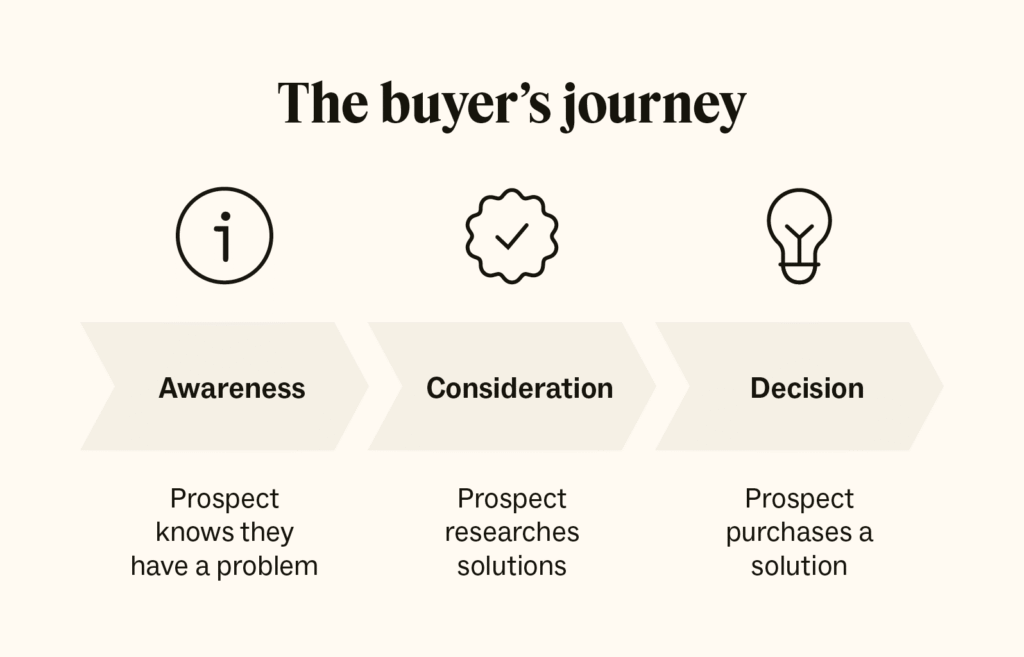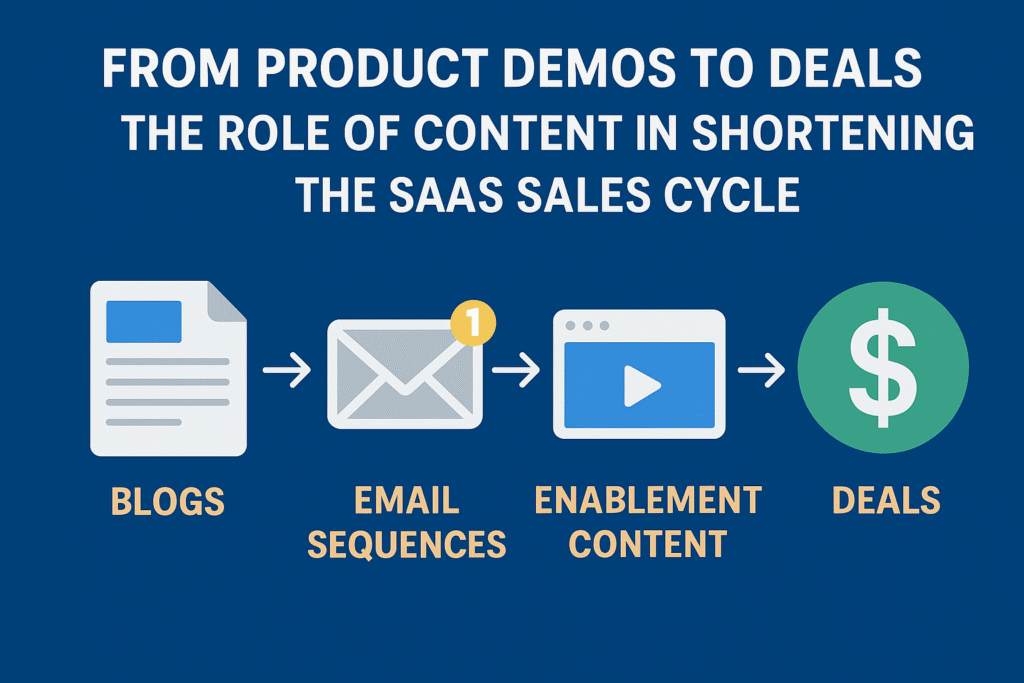If you’ve ever worked in SaaS sales, you know the feeling when a prospect loves your demo, promises to “circle back with the team,” and then disappears into the corporate void. Weeks later, you’re still refreshing your inbox like a teenager waiting for a crush to text back.

Yikes!
The reality? SaaS sales cycles are notoriously long. Enterprise deals can drag on for 6–18 months, while even SMB sales average around 84 days from first touch to close.
Why? Because buyers research obsessively, compare endlessly, and often need to get budget approval from people who don’t even know what SaaS means.

The good news is that content can accelerate the entire journey. Not the usual “brand awareness” blogs, although those are great too, but the kind of sales-ready, buyer-friendly assets that push deals forward when humans can’t.
Done right, content is the accelerant that shortens the SaaS sales cycle, nudges buyers past objections, and builds trust before a rep even joins the call.
Why SaaS Sales Cycles Drag Longer Than They Should
Let’s zoom out for a second. Why are SaaS sales cycles particularly prone to slowdowns? Because they’re more complex than traditional B2B purchases. A CRM isn’t a new desk chair, but a system that affects entire teams, requires onboarding, and usually comes with recurring costs.
Here’s a simple breakdown of what a SaaS sales cycle looks like at different company levels:
| Business Type | Average SaaS Sales Cycle | Key Decision-Makers Involved | Main Bottleneck |
| SMB | 1–3 months | Owner, ops manager | Price sensitivity |
| Mid-market | 3–6 months | Department heads, IT | Feature comparisons |
| Enterprise | 6–18 months | C-suite, procurement, legal | Internal buy-in, compliance |
Notice how the cycle length balloons with every extra layer of decision-making. What slows things down isn’t necessarily your product but the buyer’s internal politics, approval chains, and the need to justify ROI.
That’s where content marketing makes the difference. Instead of waiting for prospects to figure things out themselves, you feed them the right proof, reassurance, and clarity at each stage.
Content Is Both Marketing and Your Silent Sales Rep

There’s a big misconception in SaaS: content is for marketing, sales is for closing. Wrong.
Research reports that 70% of the B2B buying journey occurs before prospects ever speak with sales. Translation? By the time someone fills out your demo form, they’ve already consumed your blogs, checked your pricing page, read a case study, and maybe even binged your competitor’s content too.
That means content is doing the heavy lifting long before your reps get on a call. If it’s thin, generic, or hidden three clicks deep on your website, you’re basically leaving money on the table.
Think of it this way: content is the bridge between product demos and signed contracts. Without it, prospects wander around in no-man’s land.
The Content Arsenal That Actually Shortens SaaS Sales Cycles
It’s getting serious now, and you’re about to find out why. A random blog post won’t magically turn into closed-won revenue. You need specific types of content, deployed at the right stage, to accelerate the deal. Allow me to elaborate.
1. Blogs

A great blog is your first conversation with a prospect. When a buyer types “best project management tools for remote teams” at 2 a.m., your blog should be there with thoughtful, helpful insights. Done right, it educates them and nudges them toward your solution, without screaming “buy now.”
For SaaS, especially, blogs can pre-qualify leads by addressing pain points and busting myths. Let’s consider competitor comparisons. A well-written “[Your SaaS] vs. Asana: Which Tool Fits Remote Teams Best?” post can gently position you as the smarter choice.
In fact, HubSpot found that companies that blog generate 68% more leads than those that don’t. In SaaS, that’s pipeline fuel.
2. Product Demos
Scheduling demos is a classic sales bottleneck. Waiting three days for availability? That’s enough time for a hot lead to cool. But with self-serve demos, on-demand product videos, and interactive tours.
For instance, a prospect can click through your platform at midnight, show the CFO in the morning, and come to your sales call already half sold. That’s speed.
Demos aren’t just for prospects either. They double as enablement content for sales reps, who can use snippets to answer objections instantly.
Here’s how:
| Demo Format | Benefit for Buyer | Benefit for Sales |
| On-demand video | Explore anytime, share easily | Saves rep time |
| Interactive tour | Hands-on feel of product | Pre-qualifies serious leads |
| Recorded walkthrough | Consistent messaging | Training resource for reps |
3. Email Sequences

We’ve all seen it: the dreaded “Just checking in” follow-up. Buyers hate it, and reps hate sending it. Smart SaaS teams replace it with value-packed email sequences.
Instead, you can use personalized nurture tracks. For instance, post-demo, a prospect might get a case study from their industry, a one-pager tackling their top objection, or a short video on ROI. It’s less “are you ready to buy yet?” and more “here’s why you can trust us.”
Research backs this up too. McKinsey reports personalized email marketing can deliver 5–8x ROI compared to generic campaigns.
4. Case Studies
If you don’t know it already, buyers trust other buyers more than they trust you. That’s why case studies are one of the most powerful sales accelerators. A prospect hesitating over ROI will move faster when they see another company like theirs boosted pipeline velocity by 40% in 90 days.
And the format matters. Instead of a dry PDF, try video testimonials, interactive story pages, or even short LinkedIn posts highlighting key results. The faster you deliver proof, the faster you can close.
5. Sales Enablement Content
Most SaaS teams overlook this category, but it’s often the difference between a dragged-out deal and a quick win. Think battlecards, objection-handling sheets, ROI calculators, and executive-ready slide decks.
This content arms your reps and keeps buyers engaged. A CFO who can plug their numbers into your ROI calculator doesn’t need another week of budget analysis. They have their justification right there.
6. Comparison Pages

If You Don’t Own the Conversation, Competitors Will!
Your prospects are Googling “Your SaaS vs. Competitor X.” If you don’t provide a clear, honest comparison, your competitor’s blog will. That’s risky.
Well-structured “vs.” pages reduce confusion, establish trust, and prevent prospects from disappearing into research paralysis. You frame the narrative, not your rival.
7. Onboarding Content
This one’s underrated. One of the top reasons deals stall is fear of adoption. Prospects worry: Will my team actually use this? Will onboarding be a nightmare?
That’s where pre-purchase onboarding previews come in. By showing them a training video, step-by-step setup guide, or even an FAQ page before they sign, you ease fears and accelerate decision-making.
It’s like showing someone how easy it is to assemble IKEA furniture. They’ll buy the bookshelf faster.
Mapping Content to the Buyer’s Journey

If you’ve been wondering, “Okay, but when do I use what?”, here’s how it looks:
| Buyer Stage | Content Types | Goal |
| Awareness (TOFU) | Blogs, guides, webinars | Build trust, attract leads |
| Consideration (MOFU) | Demos, email sequences, comparison pages | Educate, address objections |
| Decision (BOFU) | Case studies, ROI calculators, executive decks | Provide proof, accelerate close |
| Post-purchase | Onboarding | Reduce churn, create upsell paths |
As you can see. You need to think of content as GPS. Without it, buyers take the scenic route (and scenic in SaaS means “long and expensive”).
The Measurable Impact of Content on Sales Velocity

Based on research, 47% of buyers consume 3–5 pieces of content before engaging with sales. And Forbes found that effective B2B content strategies can help companies shorten their sales cycles.
Here’s a real-world story: a SaaS startup I worked with trimmed its sales cycle from 90 days to 45 by pairing interactive demos with automated nurture sequences. They didn’t add headcount, didn’t slash prices, didn’t chase harder. They simply put the right content in the right hands at the right time.
Common Pitfalls (And How to Avoid Them)
Too many SaaS companies get content wrong. Here’s what to watch out for:
- One-size-fits-all content: A CFO and an end-user don’t care about the same things.
- Sales left out of the process: Your reps hear objections daily, so they know what content is missing.
- Feature obsession: Prospects buy outcomes, not product specs.
- Content buried in a folder: If reps can’t find it, or buyers can’t access it, it’s as good as invisible.
Try as much as possible to avoid these mistakes if you want to use content to short your SaaS sales cycle.
Best Practices for Content That Closes Deals Faster

If you want your content to truly shorten SaaS sales cycles, follow these playbooks:
- Co-create with sales: Let them guide content based on real objections.
- Tie content to account-based marketing (ABM) if you’re selling enterprise.
- Repurpose aggressively: A webinar becomes a blog, then a one-pager, then a drip campaign.
- Automate delivery: Connect your CRM so prospects get content when they need it, not a week later.
The Future of SaaS Sales Content
We’re heading into an era of hyper-personalization. A good example is demo tours that adapt based on a buyer’s industry, or AI-driven nurture tracks that know when your prospect’s CFO logged into the pricing page.
Self-serve content libraries will become standard. Buyers will want to binge content like Netflix, choosing their own journey before they even speak to sales.
The line between “marketing content” and “sales content” won’t just blur. It will vanish.
Conclusion: Content Is Your Fastest Closer
In SaaS, content isn’t decoration. It’s not “nice-to-have.” It’s the sales rep that works 24/7, handles objections before they arise, and keeps deals moving when humans can’t.
From blogs to demos, from case studies to onboarding guides, the right content at the right time is how you shorten the SaaS sales cycle, increase sales velocity, and scale without adding more reps.
So the next time someone asks, “Does content really drive revenue?” Send them this.
Quick Note (My CTA to You)
If you’re a SaaS founder, marketing agency, or sales leader tired of watching deals drag, treat content as your growth lever, not an afterthought. Build blogs that pre-qualify, demos that sell themselves, and enablement assets that make reps unstoppable.
And if you need help creating that kind of content? That’s where I come in. I specialize in SaaS and B2B writing that focuses on rankings, but more importantly, conversions!
From strategy to execution, I help brands turn content into their best-performing sales rep.
👉 Let’s connect: contact@peter-kamau.com

